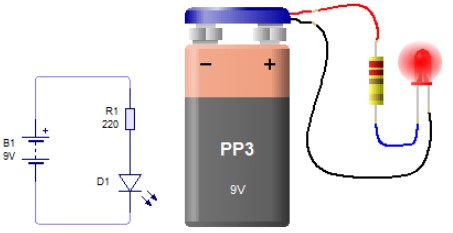Light Emitting Diodes, or LEDs, are special types of diodes that emit light when an electric current flows through them. Some of their advantages are:
• Long life and reliable
• Wide range of colours available
• Low power consumption
• Range of sizes available
• Not damaged by physical shock
• Some LEDs can produce more than one colour
LEDs are polarised, which means that they must be connected in the correct polarity for them to light up. The anode is the positive terminal and the cathode the negative. You can identify the anode and cathode by looking at the length of the leads, the shortest one is the cathode.



When the anode is connected to negative and the cathode to positive, the LED will not illuminate.

When the anode is connected to the positive and the cathode to the negative, the LED will illuminate.
If an LED were to be connected directly to a battery, it would quickly overheat and fail. This is because the LED has a very low resistance and therefore allows a large current to flow. To prevent this, a resistor is usually connected in series to limit the current flowing through it. When using small signalling LEDs it is common to limit the current to arround 20 mA (0.02 A).
An LED also has what is called a forward voltage volt-drop, which means that a certain amount of voltage is "lost" internally. This needs to be taken into account when working out what value resistor needs to be added. Different colour and power LEDs have different forward voltages and these are quoted in datasheets.


In this example we have assumed a battery voltage of 9 V, an LED with a forward voltage of 2 V and the current limited to 20 mA.
Special LEDs are manufactured that allow a single LED to display 2 or three different colour.
Bicolour LEDs
Contain two LEDs back-to-back in one package. The LED that is forward biased is the one that illuminates.
Tricolour LEDs
Contains two LEDs but has an additional centre lead. A third colour is achieved by switching on both LEDs at the same time.
RGB LEDs
Contains three LEDs, one blue, one red and one green. They are capable of producing any colour light of the spectrum by passing current through each of the LEDs in different measure.
Addressable LED strip
Each LED in the strip contains an integrated circuit (chip) which receives a digital signal telling it which colour light to produce. These can be arranged in a strip or panel to create displays.




Changing the direction of the current controls the colour.

Three colours can be produced.

